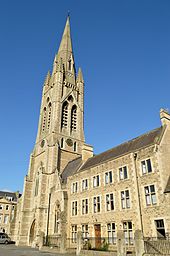St John's Church, Bath
| St John the Evangelist Roman Catholic Church | |
|---|---|

St John's Church, with parish hall and office
|
|
| General information | |
| Architectural style | Victorian architecture |
| Town or city | Bath |
| Country | England |
| Construction started | 1861 |
| Completed | 1863, spire: 1867 |
| Design and construction | |
| Architect | Charles Francis Hansom |
St. John the Evangelist Roman Catholic Church is located on the South Parade in the south-east section of Bath City Centre – the old Ham District where John Wood the Elder, the Georgian architect, had originally planned his gigantic "Forum".
The decorative Gothic-styled spire dominates the city's skyline, which has irked some people such as noted architectural critic Nikolaus Pevsner who accuses the church of being "a demonstrative proof of how intensely the Gothicists hated the Georgians of Bath." Christopher Martin takes a more measured view in his work on English Catholic churches, commenting "the stately interior is a good reflection of mid-Victorian taste", and remarking on the colourful polished marble, the exquisite screen, the blazing and triumphant white tabernacle, the delicate communion rails, a series of references to St John, and the chapels, each with something to admire.
The structure was designed and built between 1861-3 by Charles Francis Hansom, who was the brother of J. A. Hansom, the creator of the Hansom cab, and had formerly done the village church at Hanley Swan. The brothers also prepared designs for Woodchester Mansion in Nympsfield, Gloucestershire, after A. W. N. Pugin had resigned from the project. For this reason, they are often quoted as being the second best Roman Catholic architects of their day, for their success in picking up commissions Pugin had passed over. Woodchester Mansion's north service wing was also designed by them in the same Gothic style.
The walls are of Bath stone. The church's 222-foot (68 m) spire was added by Hansom in 1867. The baptistery, a shrine containing the relics of Saint Justina of Padua, was designed by Edward Joseph Hansom, his son, in 1871.
...
Wikipedia
